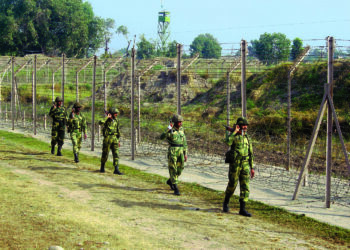Putting aside scepticism and momentary mistrust, India and the USA decide to forge ahead with the trade deal.
Trumpnomics Impacting Global Trade
Trumpnomics’ weaponising of tariffs has caused considerable volatility in global markets. The tariff sabre-rattling has secured the USA several one-sided and favourable trade agreements with smaller economies and countries that are mainly dependent on exports to the US. More than the tariffs, it is the manner in which the US has sought to arm-twist other countries to come to heel that has drawn widespread criticism, accusing the US of employing imperial tactics.
Canada, Russia, and China have condemned the tariff tyranny as blackmail and hegemonic. India has also termed the tariffs “unreasonable” and “perplexing”.
Trump Tariffs in the Supreme Court
The Trump administration imposed unilateral tariffs by invoking the Emergency Powers under the International Emergency Economic Powers Act (IEEPA) on nations that did not submit to the US tariff regime. The tariffs on imports were contested legally in the US courts. Last week, the US Court of Appeals for the Federal Circuit in Washington ruled by a 7-4 majority verdict that the sweeping tariffs imposed by Trump on countries around the world are illegal. However, the Court permitted the Trump administration until October 14, 2025, to file a petition for a writ of certiorari. Several prominent economists in the US have also raised concerns about the unilateral nature of the Trump tariffs.
The Trump administration filed a voluminous 251-page appeal in the US Supreme Court last Wednesday, broadly mentioning the following points seeking reversal of the Appellate Courts’ verdict:
- The President recently authorised IEEPA tariffs against India for purchasing Russian energy products, to deal with a preexisting national emergency regarding Russia’s war in Ukraine, as a crucial aspect of his push for peace in that war-torn country.
- The President and his Cabinet officials have determined that the tariffs are promoting peace and unprecedented economic prosperity for the USA.
- Denial of tariff authority would expose the USA to trade retaliation without effective defence and thrust America back to the brink of economic catastrophe.
- Due to IEEPA tariffs, six major trading partners and the 27-nation European Union have already entered into trade deals with the USA.
- These tariff arrangements, heavily recalibrated in America’s favour, will ensure imports and investments of approximately $2 trillion in the US economy.
- Treasury Secretary Scott Bessent claims that the tariffs “have been one of the country’s top foreign policy priorities for the last several months” and removing them “would lead to dangerous diplomatic embarrassment, expose the US to the risk of retaliation”, and “interrupt ongoing negotiations mid-stream, undermining our ability to protect the national security and economic welfare of the American people.”
India Singled Out for Imposition of Harshest Tariffs
India has been subject to the maximum US tariffs, including 25% in reciprocal tariffs and an additional 25% in secondary tariffs, for purchasing Russian Urals, effective as of 27 August 2025. According to Trump, this fuels the Russia-Ukraine war. Trump has himself accepted that India is “the largest purchaser outside of China”.
The fact is that the EU and Ukraine’s Western allies have paid more to Russia to meet their energy needs. Data from the Centre for Research on Energy and Clean Air shows Russia earned over $233 billion from fossil fuel exports to EU countries between February 2022 and February 2025. What’s more, in the past year alone, Europe’s gas imports from Russia rose by up to 20%, with LNG exports hitting record highs. Last year, China imported $62.6 billion worth of Russian petroleum and crude. Ukraine and the USA have been importing refined petroleum products from India.
Russia and China have recently signed a 30-year agreement for the supply of Siberian gas to China through two pipelines. When implemented, this arrangement is expected to cause energy inflation in Europe.
Emerging Indian Economy and Local Compulsions
India is an emerging economy. Under the China Plus One policy, a significant amount of manufacturing is shifting to India. India’s energy needs are increasing annually. Iran, a significant source of crude oil for India, dried up after the US sanctions were imposed, forcing India to explore alternative sources to meet its ever-increasing demand for crude oil. The Indian Finance Minister has reaffirmed that India’s decision to buy oil will be determined by “rates, logistics, and needs.”
The secondary tariffs have impacted human resource-intensive industries, such as textiles, gems and jewellery, marine products, and carpet weaving. The cumulative impact of these tariffs will result in the loss of jobs for hundreds of thousands of workers, leading to a human crisis. Besides, India may lose exports of tens of billions of dollars.
No Go Areas for India
The trade talks were proceeding well, with Trump also claiming a zero-tariffs deal in the near future. Something, however, soured along the way, stalling the 6th round of talks in New Delhi.
The USA sought entry into the Indian agricultural, aquaculture, and dairy sectors, among others. India is an agrarian society. Nearly fifty percent of its workforce depends on agriculture and related activities. Most of the farmers are small and marginal. The import of cheaper and heavily subsidised agricultural and dairy products from the USA will harm the interests of local farmers, which India cannot afford, both economically and politically. Prime Minister Modi has repeatedly assured the farmers that his government will not compromise their interests.
Muddying the Waters
Some of the key US government functionaries, in a no-holds-barred tirade, have accused India of single-handedly fueling the war machinery in Russia. Peter Navarro, the trade advisor to President Trump, has labelled India an “oil laundromat for the Kremlin,” betraying a total lack of understanding of India’s socio-economic and geopolitical realities. Peter Navarro was fact-checked by a community of X users, who pointed out that India’s oil trade with Russia was “for energy security, not just profit”.
President Trump has also referred to India as the “king of tariffs.” The latest to join this orchestra is none other than President Volodymyr Zelensky, who finds sanctions against “Russia backers” or India justified. “I think the idea to put tariffs on the country…continuing to make deals with Russia is the right idea,” said Zelensky in an interview with ABC News, even though Ukraine imports 15% of its diesel from India.
The accusation of making huge profits to the tune of $10-25 billion by processing the Russian Urals has been debunked by Crédit Lyonnais Securities Asia’s (CLSA) study, which pegs the gains at a meagre $2.5 billion due to higher transportation costs and the complexity of refining.
Tariffs Hurt America Too
Trumpnomics is hurting domestically as well. The release of a second consecutive poor jobs report on Friday confirmed that the labour market in the US is stalling, and the USA is facing real strain under the new economic agenda led by tariffs. The inflation report expected next week may not present happy numbers for the US President. Consumers and corporations are facing the heat of higher prices and ambivalent corporate policies. Businesses are wary of new investments and hiring. According to an article in The New York Times, “Eight months into his second term, the sum of Mr. Trump’s high tariffs and mass deportations appears to have created noticeable pressure on employers. The economy added only 22,000 jobs in August, according to the latest readout from the Bureau of Labour Statistics. The unemployment rate rose slightly, to 4.3%, a nearly four-year high. And the revised data showed that employment fell by 13,000 in June, the first net loss of jobs since the end of 2020, when the pandemic was raging.”
Gregory Daco, chief economist for the consulting firm EY-Parthenon, observes, “We’ve got a private sector that’s caught in a pinch here between these higher cost pressures and reduced demand. “Both measures, whether it’s inflation or employment, are moving in the wrong direction. They’re moving toward a stagflationary environment.”
Depth of India-America Relations
India-US relations go deeper than the Russian oil. Both democracies have strategic partnerships in the fields of defence, space, education, and technology. We have excellent people-to-people relations. The Indian diaspora is driving the US tech and economy. We are partners in the Indo-Pacific’s rule-based, free-access approach by forming the QUAD. As this piece goes online, the Indian and US armies are conducting joint exercises in the US, which will be followed by the Malabar exercise between both navies in the Indian Ocean.
The US is India’s largest trading partner with a $191 billion bilateral trade in goods and services. America is also the third-largest investor in India, with $76.26 billion in FDI coming into India from April 2000 to June 2025, accounting for 10 per cent of the total FDI India has received during this period.
Strategic Autonomy
India has pursued a foreign policy based on non-alignment and the multipolarity of the world. India has refused to join ranks with any power at the expense of the other. Jibes like sleeping with Russia and China at the cost of America do not represent the Indian diplomatic ethos. India maintains strategic autonomy by fostering friendly and business relationships with all countries. It is not a case of either with us or them.
Prime Minister Modi’s absence from two events, the grand Chinese Parade and the BRICS virtual meeting, would surely be noticed by the US and mollify their concerns to some extent.
India-US relations have been on a positive trajectory for twenty-five years. A single episode of excessive tariffs, which India finds unreasonable, should not push these relations into the abyss of mistrust and retaliation. Discussions, talks, mutual respect and consistent engagement by both sides could douse the fire in its early stages. Judicial interpretation of the US tariff actions will, however, be awaited by the world. So will be a rules-based world order.
India’s Mature Response & Resilience
India, on its part, has shown creditable restraint by not applying punitive tariffs on American imports and responding to “incorrect and misleading” social media posts. Instead, India has repeatedly requested the USA to take forward the pending trade deal. India is also looking to explore new markets for its products in approximately forty countries, with a textile and leather export potential of over $600 billion.
Statesman Trump
In the meantime, in a recent Truth Social post, Trump has hailed India and PM Modi as a “great prime minister” and a “friend”, who hopes for the continuation of the stalled trade talks. Only hours after calling on the European Union to impose 100% tariffs on China and India, Donald Trump pivoted to announce that trade negotiations with India will begin soon. Prime Minister Narendra Modi responded positively. The two leaders will hopefully speak with each other soon. Trump has stressed that he expected “no difficulty in coming to a successful conclusion for both of our great countries”.

Prime Minister Narendra Modi on Wednesday welcomed US President Donald Trump’s announcement that the two nations are pressing ahead with negotiations to resolve trade barriers, calling the United States and India “close friends and natural partners”.
Responding to Trump’s statement, Modi said he was confident the talks would “pave the way for unlocking the limitless potential of the India-US partnership.”
A clear signal emerges. Washington and New Delhi are back-channelling intensively, and the contours of a new tariff deal could be finalised by November. The potential benefits of the trade deal, which are expected to boost trade between the two countries, evoke a sense of optimism in the audience.








